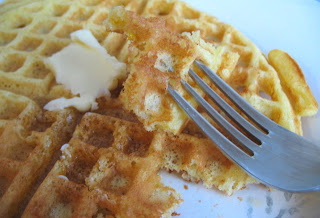First of all, this is pan-roasted chicken with a fabulous pan sauce made with pan drippings, white wine, shallots, Dijon mustard, and, in my version, half and half. (It’s what I had in the refrigerator.) As you might guess from that first sentence, the pan is somewhat important to this whole procedure. I like using cast iron for this, even though it still makes me a little nervous to put it on my glass-top stove.
I started with a whole chicken and practiced my butchering skills (which are getting pretty good, by the way) by cutting it into breasts, legs, thighs and wings. You could, of course, buy a chicken already in parts, or probably even buy just the parts you like. Whatever you choose, the chicken should be skin on and bone in.
Next, I browned my chicken pieces in that cast iron pan, then roasted them until done in the oven. Once the chicken was done, I made the lovely pan sauce by boiling chicken broth and wine (I used an inexpensive chardonnay from Trader Joe’s…my taste in and budget for wine is fairly, er, cheap) with the pan drippings and shallots. All that was left to do next was to enrich the sauce with half and half and mustard, and throw in a few bits of chopped scallion tops to make the fabulously delicious, zingy sauce that is as great on a side of mashed potatoes as it is on the roasted chicken.
This kind of recipe always deceives me just a bit. It sounds so straightforward, but requires a bit of a dance at the stove, especially when I intend to have side dishes too. If you are inclined, however, to try pan-roasting chicken this is a good recipe go with. Just remember a few things that the recipe writers rarely tell you about: 1) Be prepared for some smoke in your kitchen when cooking the chicken. Unless you have a hooded kitchen fan (I don’t) you might want to open a window or at least set someone up to deal with the smoke detector for you. 2) Be prepared to clean up a pretty greasy stove, the floor in front of the stove, and possibly the oven. Those lovely pan drippings that contribute to the delightful sauce also tend to splatter everywhere. You could also use a splatter guard if you have one (I don’t.) 3) Try to get as much set up as possible before you even begin cooking. Chop and measure ingredients and have them ready when you need them. 4) Probably the most important thing to remember is to be extremely careful when handling raw chicken. Clean up everything that touches it as soon as possible and avoid letting it drip on anything. I even change my messy apron after cutting up the chicken to avoid cross-contamination.
Of course, if you’re and old pro at pan-roasted chicken, you just skipped that last paragraph and are heading right for the recipe. More power to you. It’s delicious! There’s plenty of sauce to serve it with mashed potatoes if you like, or, if there’s any sauce leftover, it’s really nice warmed up and drizzled over scrambled eggs.
Pan Roasted Chicken with Dijon Cream Sauce
Adapted from this recipe at smitten kitchen, where it was adapted from Gourmet magazine
1 whole chicken, cut into parts (breasts, thighs, legs, and wings)
Salt and pepper to taste
1 tablespoon canola vegetable oil
¼ cup thinly-sliced shallots (about 1 large or 2 small)
¾ cup dry white wine (I used an inexpensive chardonnay, but I’ve also used other dry white wines)
¾ cup reduced-sodium chicken broth
¼ cup half and half
2 tablespoons smooth Dijon mustard
1 tablespoon finely chopped scallion tops (the green part) or use chives if available
1. Preheat oven to 450°F. Sprinkle the skin side of the chicken with salt and pepper. Heat oil in a 12-inch cast iron skillet (or other heavy, oven-proof skillet) over medium-high heat. Place about half of the chicken pieces in a single layer, skin-side down in the pan. Season the non-skin side with salt and pepper.
2. Cook the chicken until browned. This should take a few minutes. Do not move the chicken until it develops a browned crust that released easily from the pan. Turn the chicken over and brown the other side. Remove from the skillet and place on a clean plate or platter. Repeat with the remaining chicken pieces.
3. Return all chicken, skin side up, to the skillet. Place the skillet in the preheated oven and roast until the chicken is cooked through. This should take about 20 minutes, but test the chicken for doneness, preferably by inserting an instant-read thermometer probe in the thickest piece. It should be at least 165 F.
4. Transfer chicken to a platter, and cover with foil to keep warm. Return the skillet to the stove over medium-high heat. Add shallots, wine, and broth to pan juice and boil, scraping up any brown bits, until reduced by about half.
5. Add half and half and continue to boil until slightly thickened, about 1-2 minutes. Strain sauce with a sieve into a bowl. Whisk in mustard and scallion tops. Taste the sauce and adjust the seasons if desired. Transfer to a gravy boat if desired, and serve the chicken with the sauce. There should also be enough sauce to serve over a side of mashed potatoes.
Makes at least 4 servings.
Another recipe like this one: Coke Brined Chicken
One year ago: White Bean Soup with Bacon, Squash, and Kale
Two years ago: Roasted Red Pepper, Garlic, and Onion Dip



















